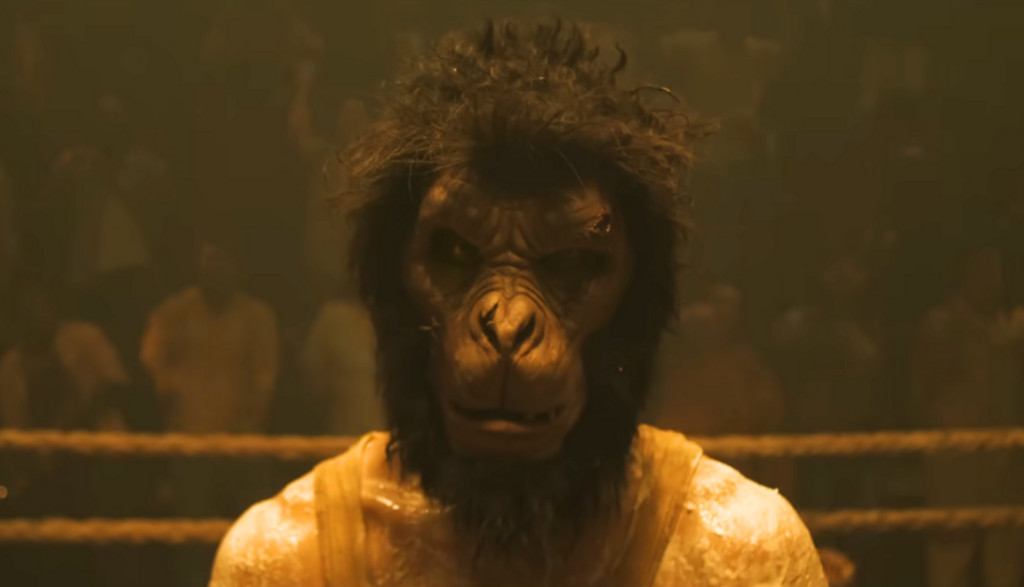CAST: Dev Patel, Sharlto Copley, Pitobash, Vipin Sharma, Sobhita Dhulipala, Sikandar Kher, Ashwini Kalsekar, Adithi Kalkunte, and Makarand Deshpande
DIRECTOR: Dev Patel
Dev Patel brings a heartfelt and influenced approach to “Monkey Man,” embodying the roles of writer, director, and lead actor. As an Oscar nominee, his earnestness meets a mix of unclear political or social messages and lukewarm execution in his directorial debut.
Styled to mimic action revenge films like “John Wick” – even referenced by characters in the movie – “Monkey Man” is Patel’s attempt at blending cinematic styles in an Indian crime narrative. However, it often feels more like an imitation in both cultural and visual terms. While the film features visually stunning and suggestive scenes, they fail to form a cohesive vision. Similarly, numerous scenes of intense action lack impact due to disjointed editing.
The titular “monkey man” is a persona of gritty underground fighting embraced by Dev Patel’s character, an unnamed man from the slums who conceals his identity with an ape mask and engages in underground brawls. His backstory, revealed through flashbacks, connects deeply with religious narratives, drawing inspiration from his mother’s (played by Adithi Kalkunte) tales of Hanuman, the monkey-like demigod from the Hindu epic, the Ramayana. This epic not only influences the film’s significant plot twists but also imbues the character with a dual sense of purpose, shaped by Hanuman’s stories. These stories, accessed through religious chants from his childhood and Hindu-themed comic books, serve as a modern entry point to Hinduism for India’s youth, guiding him on a path of compassion and vigilante justice.
In a sequence reminiscent of Danny Boyle’s dynamic filmmaking, Patel’s character skilfully engages in a pickpocketing sequence that leads him to possess the wallet of Queenie Kapoor (played by Ashwini Kalsekar), a high-end madam running an illicit brothel catering to Yatana’s (a stand-in for Mumbai) political elites. His initial reward? A humble position in the kitchen. The film touches upon class disparities with a light hand as the protagonist navigates through the ranks within Queenie’s domain, aiming for the concealed VIP area, gradually unveiling a story of revenge. The narrative, unfolding slowly over most of the film’s two-hour duration, is dotted with vivid, albeit abstract, flashbacks of police brutality, hinting at the protagonist’s motivations. His vendetta targets the corrupt commissioner Rana Singh (Sikandar Kher), entangled with the influential Baba Shakti (Makarand Deshpande), a figure whose very name signifies power.
“Monkey Man” encounters its first significant narrative hurdles in its attempt to critique political dynamics, casting Shakti as a lukewarm symbol for India’s contemporary right-wing Hindutva movement.
In Hinduism, Shakti represents the concept of divine feminine power or energy, considered the life force that animates the universe. Shakti is foundational to many Hindu goddesses, embodying the active, dynamic principles of the divine. It’s believed that every major Hindu god has a goddess counterpart, or consort, who is an embodiment of this power. For instance, Parvati is the Shakti of Shiva, Lakshmi is the Shakti of Vishnu, and Saraswati is the Shakti of Brahma.
The concept of Shakti plays a crucial role in Hindu worship and theology, especially within Shakta tradition, which focuses specifically on the worship of the goddess (Devi) in her many forms. These forms include Durga, Kali, Saraswati, Lakshmi, and more, each representing different aspects of Shakti such as creation, preservation, destruction, wisdom, and wealth.
Shakti is also integral to the philosophy of Tantra, which sees the divine feminine power as essential to spiritual growth and enlightenment. Here, Shakti is often visualized as coiled energy at the base of the spine, known as Kundalini, which can be awakened and guided through the chakras, leading to spiritual liberation.
Thus, Shakti is not just a goddess or a set of goddesses but a pervasive cosmic principle that represents the dynamic forces that move through the entire universe, embodying creation, change, and dissolution.
In Dev Patel’s world, Shakti appears as a proxy for political figures like Yogi Adityanath, with undertones reminiscent of Narendra Modi’s political maneuvers. His sermons, ostensibly on religious piety, mask a core of corruption, setting up a contrast with the protagonist’s inspiration drawn from childhood stories of righteousness and vengeance. However, the film falters in its critique; while it aims to satire the genuine extremism of Hindutva’s ideology of Hindu supremacy, the protagonist’s journey and the rhetoric used ironically align with the very essence of Hindutva, including the religious slogans that support him. This is particularly jarring when the rallying cry “Jai Bajrang Bali” is used, a phrase also associated with acts of violence against minorities in India, blurring the lines between the intended critique and the problematic alignment with the ideologies the film seeks to question.
Dev Patel’s intentions are commendable yet end up significantly off the mark. Flashbacks to the protagonist’s upbringing and his community’s struggles with police raids and land appropriation reflect real issues faced by India’s Muslims, tribal groups, and lower castes. However, Patel’s narrative choice to set this conflict during a puppet show of the Ramayana suggests an attack on Hinduism itself. Attempting perhaps to wrestle the religious imagery away from the grip of Hindutva, the film’s alignment of Hanuman with a motive for revenge yields a confusing message, as if trying to criticize, partake, and earn applause simultaneously.
The film does have its moments of commendable action. “Monkey Man” draws cinematic inspiration from a global palette, including Indonesian martial arts, Korean action cinema, and the iconic style of Bruce Lee, with clear nods to “John Wick” in its visual and thematic motifs. However, Patel’s adaptation of the signature black outfit amidst dimly lit scenes unfortunately muddles the visibility of key action sequences. The choreography, inspired by directors like Gareth Evans of “The Raid” and Timo Tjahjanto of “The Night Comes For Us,” showcases Patel’s agility and intensity through continuous, tightly framed shots — a technique not commonly seen in Hollywood.
Yet, despite Patel’s compelling performance, the direction feels derivative, as if the filmmaker emulated successful formulas without fully grasping their essence. The camera work, erratic and often too lively, detracts from the clarity of the action, creating a sense of dissonance by moving in ways that distract rather than enhance the viewing experience.
Patel lends his character a likable blend of humor and modesty, capturing the essence of an action film underdog reminiscent of Jackie Chan. However, the action sequences are sparse. A standout scene featuring an ax is executed with precision and clarity, yet it feels arbitrarily placed within the narrative, emerging from a coincidental occurrence rather than from the natural progression of the story.
The narrative ambitiously attempts to challenge authoritarianism. It includes a poignant segment where the protagonist finds refuge with a community of “hijra” (transgender person) living clandestinely, offering a glimpse into their resilience and kindness amidst adversity from law enforcement. This interlude features a surprising cameo that might puzzle those acquainted with Indian classical music.
Despite these efforts, “Monkey Man” somewhat missteps by incorporating real footage of protests against the Modi administration, yet it dilutes their significance and simplifies their complex political messages.
In a climate where governmental censorship is on the rise in India, taking a stand against sectarian oppression, as “Monkey Man” does, is commendable. Will India let the movie be released in the country? Despite this, the use of dreamlike, drug-induced perspectives by Patel to delve into imagery being used oppressively in real-life contexts (at times, even within movie theaters) does not manage to elevate or reinterpret these harsh realities in the transformative manner of S.S. Rajamouli’s work in “RRR,” despite sharing thematic parallels. So effectively what he fails in is making the Bollywoodish impact that telling a tale like this may require.
The film resonates as a deeply personal venture for Patel, drawing from the action influences of his youth and showcasing an Indian milieu through the nostalgic lens of childhood experiences.
Revisiting the Mumbai slums, a recurring setting in his most acclaimed films like “Slumdog Millionaire” and “Lion,” adds a thoughtful, self-reflective layer to his work. Having grown up in England but frequently cast in Hollywood as characters from India, Patel’s relationship with Mumbai has significantly shaped his public image, further underscored by his role in “Hotel Mumbai,” a film about the 2008 terrorist attacks in the city.
His portrayal of a native Mumbaikar has evolved, offering a more nuanced performance than earlier roles, although it doesn’t match the comedic timing of co-star Pitobash, who adds a refreshing contrast. The film’s depiction of Mumbai’s darker aspects aligns it with the works of Ram Gopal Varma, known for his gritty gangster films, yet “Monkey Man” tends to blur cultural specifics for an international audience, leaving details feeling simultaneously underdeveloped and overly simplified.
The shortcomings in Patel’s directorial debut—particularly in action and political commentary—shouldn’t be seen as fatal flaws in his career. His ability to evoke atmosphere and introspection hints at potential, even if he faces challenges in achieving thematic and visual coherence. “Monkey Man” shows promise in its action sequences, yet it often falls short of delivering the impactful climaxes or emotional release one might hope for.
Dev Patel’s genuine earnestness meets its match in the awkward handling of religious symbols within a narrative of vengeance set in India, where lackluster action sequences cannot compensate for the confused political undertones.
His inspirations are unmistakably present, drawing from “The Raid,” “John Wick,” and the legendary Hong Kong director Sammo Hung.
Yet, the attempt to blend dynamic action choreography with topical themes seldom results in anything compelling or novel. “Monkey Man” leans heavily into mimicry, homage, and cultural replication, falling short of achieving a distinctive or impactful cinema experience.







